Deliberate crash landings on extraterrestrial bodies
These are tables of space probes (typically orbiters or components thereof) which have been deliberately destroyed at their objects of study, typically by hard landings or crash landings at the end of their respective missions and/or functionality. This suicidal endeavor not only precludes the hazards of orbital space debris and planetary contamination, but also provides the opportunity in some cases for terminal science given that the transient light released by the kinetic energy may be available for spectroscopy; the physical ejecta remains in place for further study. Even after soft landings had been mastered, NASA used crash landings to test whether Moon craters contained ice by crashing space probes into craters and testing the debris that got thrown out.[1]
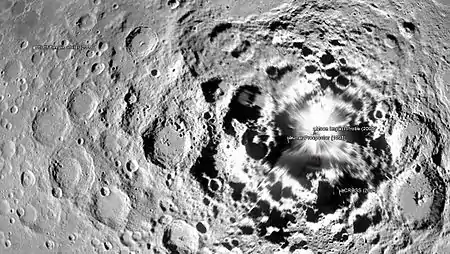

Several rocket stages utilized during the Apollo space program were deliberately crashed on the Moon to aid seismic research, and four of the ascent stages of Apollo Lunar Modules were deliberately crashed onto the Moon after they had fulfilled their primary mission.
The Deep Impact mission had its own purpose-built impactor which hit Comet 9P/Tempel 1. Terminal approaches to gas giants which resulted in the destruction of the space probe count as crash landings for the purposes of this article.
The crash landing sites themselves are of interest to space archeology.
Luna 1, not itself a lunar orbiter, was the first spacecraft designed as an impactor. It failed to hit the Moon in 1959, however, thus inadvertently becoming the first man-made object to leave geocentric orbit and enter a heliocentric orbit, where it remains to this day.
Mercury
| Mission | Country/Agency | Date of landing/impact | Coordinates | Notes |
|---|---|---|---|---|
| MESSENGER | 30 April 2015 | Probably around 54.4° N, 149.9° W, near the crater Janáček | Intentionally crashed at end of mission. |
Moon
| Mission | Country/Agency | Date of landing/impact | Coordinates | Notes |
|---|---|---|---|---|
| Luna 2 | 13 September 1959 | 29.1°N -0°E | Intentional hard impact. | |
| Ranger 4 | 26 April 1962 | 15.5°S 130.7°W | Intentional hard impact; hit lunar far side due to failure of navigation system. | |
| Ranger 6 | 2 February 1964 | 9.4°N 21.5°E | Intentional hard impact. | |
| Ranger 7 | 31 July 1964 | 10.35°S 20.58°W | Intentional hard impact. | |
| Ranger 8 | 20 February 1965 | 2.72°N 24.61°E | Intentional hard impact. | |
| Ranger 9 | 24 March 1965 | 12.83°S 2.37°W | Intentional hard impact. | |
| Lunar Orbiter 1 | 29 October 1966 | Lunar orbiter, intentionally crashed at end of mission. | ||
| Hiten | 10 April 1993 | Lunar orbiter, intentionally crashed at end of mission. | ||
| Lunar Prospector | 31 July 1999 | 87.7°S 42.1°E | Lunar orbiter, intentionally crashed into polar crater at end of mission to test for liberation of water vapour (not detected). | |
| SMART-1 | 3 September 2006 | Lunar orbiter, intentionally crashed at end of mission. | ||
| Chandrayaan-1 Moon Impact Probe | 14 November 2008 | Impactor. Water found. | ||
| SELENE Rstar (Okina) | 12 February 2009 | Lunar orbiter, intentionally crashed at end of mission. | ||
| Chang'e 1 | 1 March 2009 | Lunar orbiter, intentionally crashed at end of mission. | ||
| Kaguya | 10 June 2009 | Lunar orbiter, intentionally crashed at end of mission. | ||
| LCROSS (Centaur) | 9 October 2009 | 84.675°S 48.725°W 84.729°S 49.360°W |
Impactors -main craft flew through the plume of lunar dusted created by its own upper rocket stage gathering data. Water confirmed. | |
| Longjiang 2 | 31 July 2019 | 16.6956°N 159.5170°E[2] | Micro-satellite, intentionally crashed at end of mission. |
Mars
| Mission | Country/Agency | Date of landing/impact | Coordinates | Notes |
|---|---|---|---|---|
| Mars Science Laboratory Skycrane | 6 August 2012 | Bradbury Landing 4.5895°S 137.4417°E | Debris fields created by the heat shield, Sky Crane, and other components. |
Comets
| Mission | Country/Agency | Date of landing/impact | Coordinates | Notes |
|---|---|---|---|---|
| Deep Impact | 4 July 2005 | Tempel 1 | The "Smart Impactor" had a payload of 100 kg of copper, which at its closing velocity 10.2 km/s had the kinetic energy equivalent to 4.8 tonnes of TNT. | |
Jupiter
| Mission | Country/Agency | Date of landing/impact | Notes |
|---|---|---|---|
| Galileo atmospheric probe | 7 December 1995 | Functioned for 57.6 minutes. | |
| Galileo | 21 September 2003 | Disintegrated in the Jovian atmosphere. |
Saturn
| Mission | Country/ Agency | Date of landing/impact | Coordinates | Notes |
|---|---|---|---|---|
| Cassini orbiter | 15 September 2017 | 9.4°N. 53°W. | 30 seconds of terminal data, more than anticipated, were received prior to Cassini's disintegration in Saturn's atmosphere. |
Chronological Gallery
 Ranger 4
Ranger 4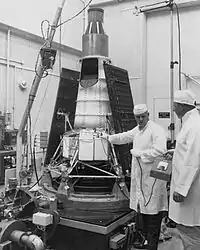 Ranger 6
Ranger 6 Rangers 7, 8, and 9
Rangers 7, 8, and 9.jpg.webp) Lunar Orbiter 1
Lunar Orbiter 1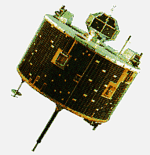 Hiten
Hiten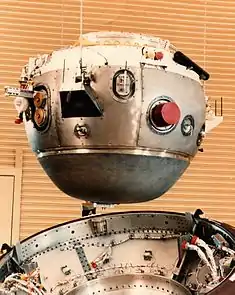 Galileo Probe
Galileo Probe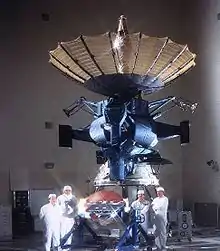 Galileo
Galileo Lunar Prospector
Lunar Prospector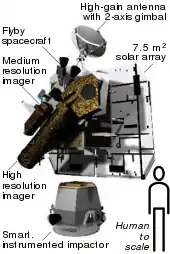 Deep Impact
Deep Impact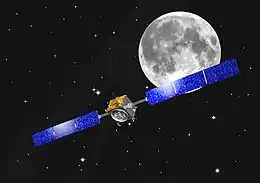 SMART-1
SMART-1.jpg.webp) Chandrayaan-1
Chandrayaan-1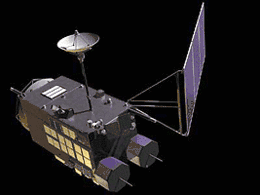 SELENE (Kaguya)/Okina
SELENE (Kaguya)/Okina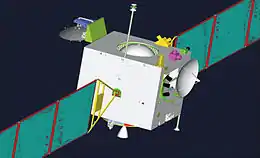 Chang'e 1
Chang'e 1 LCROSS
LCROSS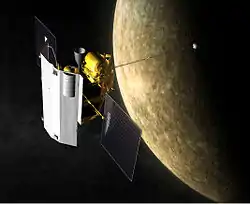 MESSENGER
MESSENGER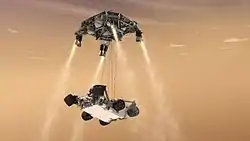 Mars Science Laboratory
Mars Science Laboratory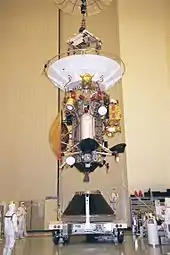 Cassini
Cassini
See also
References
- "Crash Landing on the Moon". NASA Science. Retrieved April 20, 2016.
- Robinson, Mark (November 14, 2019). "Longjiang-2 Impact Site Found!".
.jpg.webp)